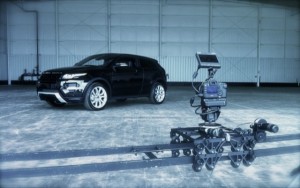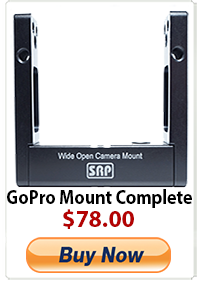Camera Movement Then And Now.
Camera movement is something we all take for granted this past half decade. We used to have bigger cameras, heavy dollies, camera cranes etc that required a large crew to man and rig. Cameras now of course are much smaller, lighter and allow us to get shots we couldn’t with say a MovieCam Compact or a Arri 4BLs. Because cameras have changed so much we have access to tools to help move the camera in ways we never could before. New filmmakers who haven’t been in the business past this last decade have an almost unlimited amount of options to get the camera from point A to point B. There were a handful of should mount rigs, reason being that most cameras already had that form factor built in.
Dollies (forward/backward, side-to-side) :
Back in the day, dollies where the only way to do a tracking shot unless you had a lot of money or knew a Steadicam Operator. Setting up dolly track was a long and tedious process. Laying down heavy steel track, unloading the Fisher dolly off the truck, etc required more than two people and required a lot of space. Renting a dolly was expensive. Dollies featured hydraulic booming, crabbing wheels, etc. Even a doorway dolly took up at least 3 feet of space and could barely move through a doorway. Setting up a tracking shot in an small apartment for example wasn’t doable unless you built a pipe dolly or your own contraption to make it happen. Now we have great options from companies like Kessler Crane, Camblock, Ditto Gear, etc. Shots I used to use a Mathews doorway dolly for in the past, I now do with a Kessler Crane Shuttle Pod System or K-Pod Dolly with flexi track. Set up takes less than 10 minutes and transport is simple and easy. I no longer use a truck to transport my camera support instead I load up my car and still have ample room.
Steadicam (any direction including slight booming shots):
Not many people had access to a Steadicam. Fifteen years ago there were really only two Steadicam options. Steadicam brand and George Paddock Industries GPI. For the most part you couldn’t rent a Steadicam rig as no one dire hired and the rigs were significantly bigger and heavier (since pro cameras were 15-65lbs). The other major reason was that Steadicam operating is a high end skill that requires extensive training and practice. So the option was to hire a Steadicam Operator with a rig and their assistant. This was expensive. I know as I am a Steadicam Operator for over 15 years. After the Steadicam patent ran out it opened the doors to other companies to make rigs. Glidecam, XCS, MK-V, GPI, Movcam, etc started making rigs and opened up the offerings. At the same time cameras started to become more compact, the quality improved and they became lighter. This allowed Steadicam and other stabilizer rigs to become lighter, easier to use and much more affordable to the masses. A Steadicam rig back in 1997 was $60,000 +. A Steadicam now a days is as little as $599. It was only the past four years that cameras like the 5D MKII allowed for very light weight rigs like the Glidecam 1000-4000HD series to become viable options for smooth run and gun shooting.
Shoulder Mount Rigs (for mobile semi-stabilization):
Cameras film and video had a much different form factor of the cameras of today. Cameras like the Aaton XTR Prod, Arri SR2, and others had magazines that extended that balanced out the weight of a lens and matte box on the front of the camera. Due to that fact a shoulder mount rig really wasn’t needed. Cameras also had Arri Rosettes so you could attach handles to the camera body. Cameras these days lack these features and tend to be front heavy and lack ergonomics for shoulder mounting. Now a days there are over 20 shoulder mount systems and more being manufactured everyday to make up for the lack of rig-ability, form factor and balance. Zacuto, Red Rock Mico, Shape and Letus being the major stand outs in this group. Almost every shooting including myself use a combination of a few different companies to make the best solution for their style of shooting and accessory rigging needs.
Cranes and Jibs (booming up/down, side-to-side:
Cranes and jibs were beasts till about 15 years ago. Camera cranes were clunky, huge, heavy and required a crane operator in most cases. They were meant to hold much heavier cameras and in many cases a camera operator w/AC or robotic head. Crane shots were almost unheard of in independent films unless you built one yourself or knew someone. Jibs were also fairly heavy duty and were far and few between. There were only a few companies that made them and there were expensive. Now we have Kessler Crane, Glidecam, Libec, Matthews, etc making affordable solutions for today’s cameras. Jibs and cranes also are now made with space and storage confinements as considerations in mind. They fold up, pack tight and can fit in most passenger cars.
Robotic Heads (pan/tilt and sometimes roll):
Robotic heads were rare on low budget commercials and features. There were only a few options and they had to be rented out of LA, NYC, Miami or Chicago. No one I knew owned a Power pod or Libra head or anything close. Usually these were two axis heads and you could add a third axis for a large price jump. These heads were over $60,000 and required a skilled operator to use them. With improvements in technology and lighter cameras the doors have been opened up. You can now buy a robotic head with a controller for under $2,000 which is amazing when you think about it. You can repeat shots and do basic motion control for 1/30th of the cost. Now everyone can set up decent composite shots that were unattainable even ten years ago outside of having a Hollywood budget.
With all the tools we have now have available and at prices that most can afford there is no reason why we can’t have fluid and dynamic shots on projects of every budget. Take advantage of these tools and use them wisely. Most of us would have had to put aside a decent portion of the budget to get the perfect crane, steadicam or dolly shot. We can do this for next to nothing now that rental companies and friends all own this once unattainable gear.
Mike Sutton @MNS1974











